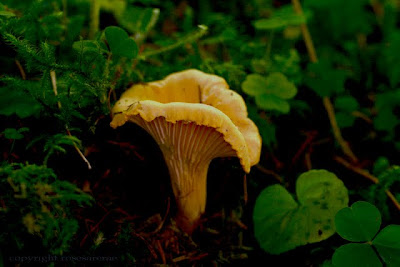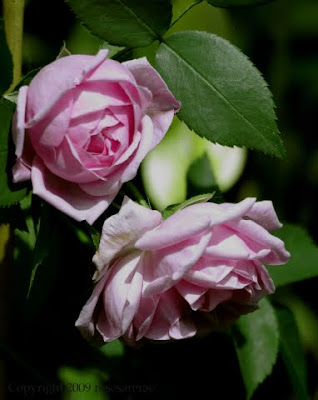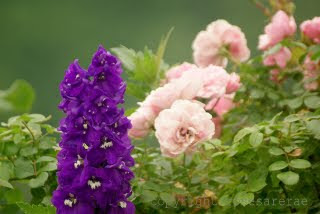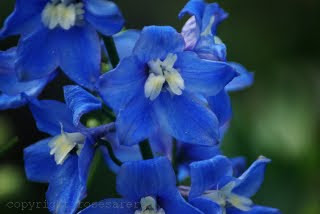 The weedy hazels are going nuts! They are steadily falling all over the place at the back patio and rolling down the garden staircase. Some will be eaten by the wildlife, collected by the garden mouse and squirrels for their winter food and a few will sprout out by themselves next spring.
The weedy hazels are going nuts! They are steadily falling all over the place at the back patio and rolling down the garden staircase. Some will be eaten by the wildlife, collected by the garden mouse and squirrels for their winter food and a few will sprout out by themselves next spring.There's time to grow and there's time to die, and autumn really is the beginning of the decaying stage to some plants's tissue prior to winter freeze.
The days around here are becoming shorter and shorter and the mornings are very foggy. Very soon, I will be seeing only a few hours of sun after the fog disappeared. At this time of year, the sun has lost its teeth too. The sun maybe shining but not warm enough to go around without a jacket or pullover to comfort the goosebumps.
 With the temperature steadily cooling down, some plants' leaves are slowly losing their ability to photosynthesize. The first one to change colours in the backyard are the parthenocisus creepers.
With the temperature steadily cooling down, some plants' leaves are slowly losing their ability to photosynthesize. The first one to change colours in the backyard are the parthenocisus creepers.
The Red Ace seedpods of Euonymus Europeaus or European Spindle tree are also ripening pink, and very soon the seedpods will split open revealing an orange coloured seeds.
This snail is eating the fungi that are growing on dead leaf.
For a long time, I thought the snails are similar to the destructive habits of the slugs Arion lusitanicus Mabille, Stylommatophora, Arionidae etc etc.
I've always thought they ate soft new growth on plants just like the slugs, but recently, I found out that the garden snails feed mainly on fungus that grow on decomposing matter. It is only during spring time that these snails run out of food options because during that time of year, the ground temperature is still too cold and the rate of decomposing matters are zero to none. Poor thing is so hungry after a long winter sleep, that when they stumble on our plant seedling, they are not able to distinguish between food and potential garden beauties. At other time of year, these snails are happy to leave the garden beauties and live on fungi, especially those that grow on leaf surfaces. Sticking themselves underneath the leaves also helped them hide from the snail eating predator birds. 
Mould, fungi, fungus and their spores are stirred up by damp conditions, more so during autumn weather. The ground is still warm and the humidity helped the fungi to speed up the rotting and decomposing of vegetation from the falling leaves etc. This is part of the nature's organic recycling. There are many different kinds of spores floating in the air that we breathe and when the condition is right for them to settle down, they will grow and thrive. Without the help of the fungi, our garden soil will be starved of decomposing organic nutrients.
There are good and bad things about the mould, fungi and fungus and can be found anywhere, even in our fridge, any part of the house that is damp with poor air circulation, such as the bathroom, inside our shoes, on our skin, nail bed, garden bed, shady areas which receive minimal sunlight, on the plants and their leaves and the list could go on and on. This is one of the reason why watering roses in the late evening is not encouraged, because night dampness enable the blackspot spores to adhere to the wet leaves.
 Where weather is rainy, blackspot infection becomes prevalent like the picture above. This year, a very serious case of fungal infection was seen on Yolanda d'Aragon's leaves. Black spot is apparently more prevalent in areas with clean air and low pollution. It seems that the blackspot fungus cannot grow on leaves that are covered with a layer of pollution grime.
Where weather is rainy, blackspot infection becomes prevalent like the picture above. This year, a very serious case of fungal infection was seen on Yolanda d'Aragon's leaves. Black spot is apparently more prevalent in areas with clean air and low pollution. It seems that the blackspot fungus cannot grow on leaves that are covered with a layer of pollution grime.  Since I garden organically without chemical spraying, half of my roses bushes had already shed their leaves due to the black spot. Christopher Marlowe above is no exception, but as my gardening friend Maribel once said, "what is a little bit of spottiness amongst friends", so I let it be. Afterall, this blackspot fungi is not hazardous to human's health. Given the fact that I only garden for my own pleasure and as long as the blooms brings joy and smiles everytime I step out into the garden, I have learned to ignore, pick up the black spotted leaves and throw them away.
Since I garden organically without chemical spraying, half of my roses bushes had already shed their leaves due to the black spot. Christopher Marlowe above is no exception, but as my gardening friend Maribel once said, "what is a little bit of spottiness amongst friends", so I let it be. Afterall, this blackspot fungi is not hazardous to human's health. Given the fact that I only garden for my own pleasure and as long as the blooms brings joy and smiles everytime I step out into the garden, I have learned to ignore, pick up the black spotted leaves and throw them away.There are other fungi, or otherwise also known as mushroom that popped up in the wild especially during this time of year. Some mushrooms are edible, considered a gourmet delicacy, such as this golden egg yolk chanterelle mushroom
 and there are also a few which has been identified containing medicinal values.
and there are also a few which has been identified containing medicinal values. Mushroom farming has enabled us to enjoy certain type of mushroom all year round, but in autumn, collecting edible mushroom from the wild can be very adventurous and fun thing to do but this must be done only with someone who is a mushroom expert. Some mushrooms are poisonous. Ingesting this pretty looking mushroom (picture below) can cause harm to human's health but interestingly not the slugs! 

Here's a cropped part of the slug from the picture above.
This goes to show that there is nothing poisonous which can kill slugs.


 It can grow to 12 feet, so I will put an arch to support the canes next spring.
It can grow to 12 feet, so I will put an arch to support the canes next spring.

 The whole bunch of my spring blooms from this 2 roses was unable to open up during spring and early summer.
The whole bunch of my spring blooms from this 2 roses was unable to open up during spring and early summer.  The petals got saturated after the rain and they end up rotting inside the mumified dried-out outer petal crust.
The petals got saturated after the rain and they end up rotting inside the mumified dried-out outer petal crust.


 The weather is bad at the moment. I have now added my local weather station on the top page. As I rumble and ramble about life in the alps, you can see for yourself if I'm shining under the sun or bundled up in layers of wool knits with chattering teeth.
The weather is bad at the moment. I have now added my local weather station on the top page. As I rumble and ramble about life in the alps, you can see for yourself if I'm shining under the sun or bundled up in layers of wool knits with chattering teeth.  There's no sun at all the last couple of days. Some parts of the garden is beginning to look very gloomy as half of the colourful flowering plants are done with their flowers and busy making seeds. Weedy seeds can be seen on cobwebs everywhere.
There's no sun at all the last couple of days. Some parts of the garden is beginning to look very gloomy as half of the colourful flowering plants are done with their flowers and busy making seeds. Weedy seeds can be seen on cobwebs everywhere.  We have cold air coming down from the north pole at the moment and it is raining, foggy and grey sky, but this cooling temperature will create a magical autumn colour display for the next coming weeks. Had to push myself out into the garden, with an umbrella in one hand and took some pictures before the prolonged rain spoils those last bit of garden beauties.
We have cold air coming down from the north pole at the moment and it is raining, foggy and grey sky, but this cooling temperature will create a magical autumn colour display for the next coming weeks. Had to push myself out into the garden, with an umbrella in one hand and took some pictures before the prolonged rain spoils those last bit of garden beauties. Mevrouw Nathalie Nypels, sounds like a celebrity's baby's name (ha ha) This is a Dutch name and this rose was bred in the Netherlands in 1919.
Mevrouw Nathalie Nypels, sounds like a celebrity's baby's name (ha ha) This is a Dutch name and this rose was bred in the Netherlands in 1919.  I got this rose as a bare roots last winter and she is less than 2 feet tall but she didn't waste anytime at all this year. Bloom cycle is very short and every few weeks there's a bunch of flowers on the bush. There are no fragrant unfortunately, but for the joy of blooms, and adding some colours in general landscaping, I find this rose is very hard working.
I got this rose as a bare roots last winter and she is less than 2 feet tall but she didn't waste anytime at all this year. Bloom cycle is very short and every few weeks there's a bunch of flowers on the bush. There are no fragrant unfortunately, but for the joy of blooms, and adding some colours in general landscaping, I find this rose is very hard working.  I didn't have a "real" holiday this year because I forgotten to make proper plan during 2008 hectic year. It has never happened before that I was so busy to the point that I forgotten about planning annual leave but I am lucky to have such great friends who made my short 10 summer days spent with them unforgettable. I was in a beautiful region in northern Italy, breathtaking landscape, challenging climbing walls with endless treks for mountain biking and walking around. I will update my summer add-ventures blog later. More than 1000 pictures to resize!In between rock climbing and all the outdoor adventures, I also managed to document some roses that grew up on that altitude.
I didn't have a "real" holiday this year because I forgotten to make proper plan during 2008 hectic year. It has never happened before that I was so busy to the point that I forgotten about planning annual leave but I am lucky to have such great friends who made my short 10 summer days spent with them unforgettable. I was in a beautiful region in northern Italy, breathtaking landscape, challenging climbing walls with endless treks for mountain biking and walking around. I will update my summer add-ventures blog later. More than 1000 pictures to resize!In between rock climbing and all the outdoor adventures, I also managed to document some roses that grew up on that altitude.

 This year, since mid spring until now, Stanwell Perpetual has been very generous and very floriferous and there are still little buds forming even at this time of year. This is one rose I will take with me to the graveyard. Shall add that the next time I update the will. Ha ha.
This year, since mid spring until now, Stanwell Perpetual has been very generous and very floriferous and there are still little buds forming even at this time of year. This is one rose I will take with me to the graveyard. Shall add that the next time I update the will. Ha ha.